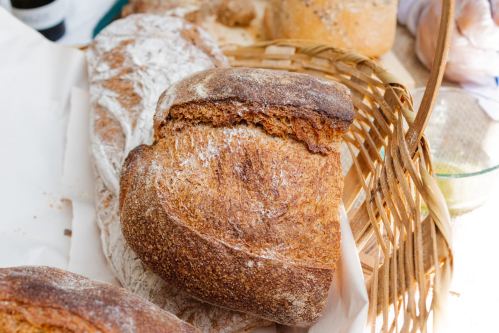The healthiest bread to eat according to RDs is a Mediterranean diet staple
Whether you're on the Mediterranean diet or just love carbs, experts share the healthiest bread to eat (and which ones you should avoid).

By now, you’ve likely come across your fair share of smack talk about bread: It causes brain fog! Will give you dementia! Makes you fat! But if you’re of the Mediterranean diet persuasion (or you just love carbs and want another reason to eat them) good news: Bread is absolutely on the menu.
“Bread is a traditional part of the Mediterranean diet,” says Christy Brissette, RD, president of 80 Twenty Nutrition in Chicago. “Stone ground, whole grain flour was made into homemade breads and pitas and eaten alone or dipped into olive oil, bean or yogurt dips.”
Of course, not all breads are equal. “When you think about the health benefits of the Mediterranean diet, think traditional: Go for whole grain versus refined grains,” she says. In a nutshell, the healthiest bread to eat (whether you’re on the Med diet or not) is a classic whole grain bread. “Whole grains contain fiber, antioxidants and phytochemicals as well as B vitamins, vitamin E, iron and magnesium,” Brisette says. “Eating whole grains regularly is linked to a lower risk of type 2 diabetes, obesity, heart disease, stroke and some types of cancer.”
Keri Glassman, MS, RD, CDN, co-founder and CEO of The Nutritious Life Studio CEO, agrees—but with a twist. “Personally, I always go for sprouted bread, like Ezekiel bread, because it’s made with whole grains and it has zero sugar,” she says. According to Glassman, sprouted breads are often made with sprouted whole grains or legumes, which up the protein count.

These two points, Glassman says, are key when choosing which bread toss in your cart—no matter what eating plan you choose. She says a lot of breads have sugar and additives like hydrogenated oils in them. “You want to save your sugar for something like a chocolate chip cookie you’ve been craving or a piece of fruit, not for bread,” she says.
As far as other ingredients to watch out for, Glassman says to eyeball the sodium count; many store-bought sliced breads are full of it. (Pro tip: Aim for under 200 milligrams; bonus points if you keep it to under 100 milligrams.) “Another ingredient you see a lot is soybean flour or isolated soy proteins,” Glassman says. “Too much soy in our diet is not good, especially processed soy, so that is definitely something to avoid with bread.”
“Some brands say ‘wheat flour.’ That means nothing. All flour is wheat flour.” —Keri Glassman, certified nutritionist
To her other point, going for a whole grain option is going to give you the most nutritional benefits. And the key is making sure the loaf is 100-percent whole grain—not just whole wheat bread. “Some brands say ‘wheat flour.’ That means nothing. All flour is wheat flour,” Glassman says. Look for a brand that has at least three grams of fiber per slice, adds Brissette, to ensure you’re getting the most staying power per serving.
The experts’ least favorite bread will come as a surprise to absolutely no one. “[White bread] really is the worst because it’s just processed sugar,” Glassman says. “Traditional white bread is made with sugar, canola oil, and dry preserved yeast to leaven the dough.” And don’t be fooled by multigrain bread, which is basically “white bread in disguise,” adds Brissette. “People think it’s healthy, but the word just means there are different types of grains in the bread. They aren’t always whole grain.”
Basically, stick to whole grain loaves with real ingredients and your body will recognize that what you’re eating is the best thing since, well, you know.
With additional reporting by Jessie Van Amburg.
This piece was originally published on July 12, 2018. It was updated on March 29, 2019.
If you’re seriously craving some bread now, try this gluten-free prebiotic banana bread or this long-fermented bread.










